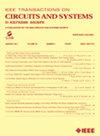Robust and Reliable Energy-Efficient Level Shifter
IF 4
2区 工程技术
Q2 ENGINEERING, ELECTRICAL & ELECTRONIC
IEEE Transactions on Circuits and Systems II: Express Briefs
Pub Date : 2025-03-03
DOI:10.1109/TCSII.2025.3547667
引用次数: 0
Abstract
In this brief, we propose an energy-efficient level shifter (LS) for converting a wide range of supply voltages for digital integrated circuit applications. The proposed novel circuit is a two-stage LS comprising of current mirror (CM) based circuit followed by the split inverter. A feedback mechanism, current-limiter PMOS, and pass transistor are used to resolve the current contention, static power dissipation, and improved minimum conversion time. The proposed LS shows a reduced impact of variability across various PVT corners, making it a viable solution for low-voltage digital systems. The proposed LS shows a propagation delay of 3.01 ns (0.67 ns), an energy per transition of 1.84 fJ (0.595 fJ) for converting 0.3 V (0.2 V) to 1.2 V (1 V) in CMOS 65 nm (FDSOI 28 nm) process, and a lower energy-delay product (EDP) compared to current state-of-the-art designs. With static power dissipation of 280 pW at 0.3 V input, it also features an average minimum convertible input level (稳健可靠的节能档移档器
在本简报中,我们提出了一种节能电平移位器(LS),用于转换数字集成电路应用的广泛电源电压。所提出的新电路是由基于电流反射镜(CM)的电路和分路逆变器组成的两级LS。采用反馈机制、限流PMOS和通型晶体管来解决电流争用、静态功耗和改进的最小转换时间。所提出的LS减小了各种PVT拐角的可变性的影响,使其成为低压数字系统的可行解决方案。所提出的LS显示出3.01 ns (0.67 ns)的传播延迟,在CMOS 65 nm (FDSOI 28 nm)工艺中将0.3 V (0.2 V)转换为1.2 V (1 V)的每次跃迁能量为1.84 fJ (0.595 fJ),并且与当前最先进的设计相比,具有更低的能量延迟产物(EDP)。它在0.3 V输入时的静态功耗为280 pW,在1 mhz (20 mhz)频率下的平均最小可转换输入电平($\rm V_{DDL}$)为100 mV。在Cadence VIRTUOSO和Synopsys HSPICE环境下,在商用CMOS 65 nm和FDSOI 28 nm工艺中进行了仿真。
本文章由计算机程序翻译,如有差异,请以英文原文为准。
求助全文
约1分钟内获得全文
求助全文
来源期刊
CiteScore
7.90
自引率
20.50%
发文量
883
审稿时长
3.0 months
期刊介绍:
TCAS II publishes brief papers in the field specified by the theory, analysis, design, and practical implementations of circuits, and the application of circuit techniques to systems and to signal processing. Included is the whole spectrum from basic scientific theory to industrial applications. The field of interest covered includes:
Circuits: Analog, Digital and Mixed Signal Circuits and Systems
Nonlinear Circuits and Systems, Integrated Sensors, MEMS and Systems on Chip, Nanoscale Circuits and Systems, Optoelectronic
Circuits and Systems, Power Electronics and Systems
Software for Analog-and-Logic Circuits and Systems
Control aspects of Circuits and Systems.

 求助内容:
求助内容: 应助结果提醒方式:
应助结果提醒方式:


